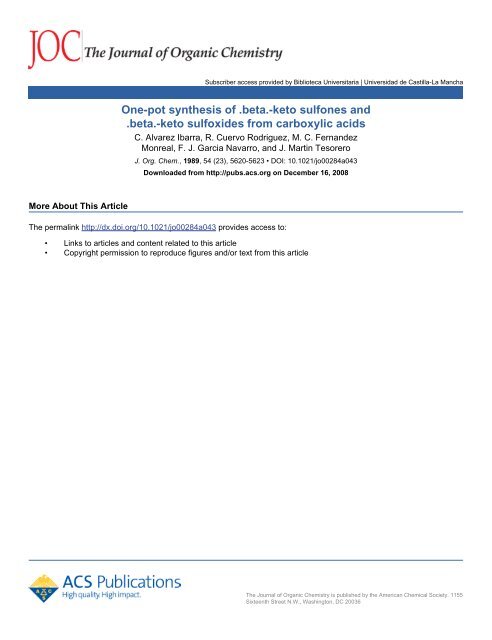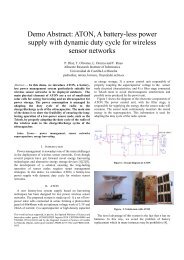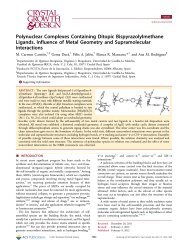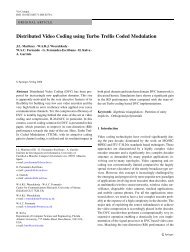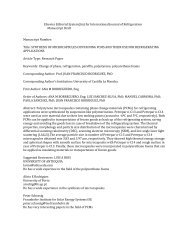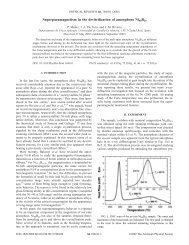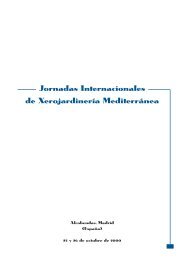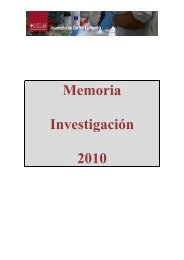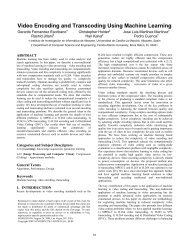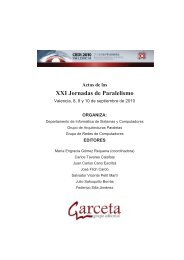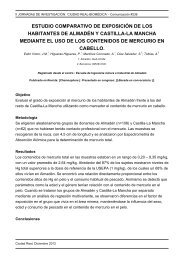One-pot synthesis of .beta.-keto sulfones and .beta.-keto sulfoxides ...
One-pot synthesis of .beta.-keto sulfones and .beta.-keto sulfoxides ...
One-pot synthesis of .beta.-keto sulfones and .beta.-keto sulfoxides ...
You also want an ePaper? Increase the reach of your titles
YUMPU automatically turns print PDFs into web optimized ePapers that Google loves.
More About This Article<br />
Subscriber access provided by Biblioteca Universitaria | Universidad de Castilla-La Mancha<br />
<strong>One</strong>-<strong>pot</strong> <strong>synthesis</strong> <strong>of</strong> .<strong>beta</strong>.-<strong>keto</strong> <strong>sulfones</strong> <strong>and</strong><br />
.<strong>beta</strong>.-<strong>keto</strong> <strong>sulfoxides</strong> from carboxylic acids<br />
C. Alvarez Ibarra, R. Cuervo Rodriguez, M. C. Fern<strong>and</strong>ez<br />
Monreal, F. J. Garcia Navarro, <strong>and</strong> J. Martin Tesorero<br />
J. Org. Chem., 1989, 54 (23), 5620-5623 • DOI: 10.1021/jo00284a043<br />
Downloaded from http://pubs.acs.org on December 16, 2008<br />
The permalink http://dx.doi.org/10.1021/jo00284a043 provides access to:<br />
• Links to articles <strong>and</strong> content related to this article<br />
• Copyright permission to reproduce figures <strong>and</strong>/or text from this article<br />
The Journal <strong>of</strong> Organic Chemistry is published by the American Chemical Society. 1155<br />
Sixteenth Street N.W., Washington, DC 20036
5620 J. Org. Chem. 1989,54, 5620-5623<br />
million (ppm) downfield relative to tetramethylsilane. lgF NMR<br />
chemical shifts are given in parts per million downfield relative<br />
to trichlor<strong>of</strong>luoromethane. IR spectra were recorded on a Perkin-Elmer<br />
1420 spectrometer <strong>and</strong> are expressed in cm-'. Elemental<br />
analyses were performed by the Service de Microanalyse,<br />
Universit6 Pierre et Marie Curie, Paris. Mass spectra were determined<br />
on a Nermag R30-10 instrument by Pr<strong>of</strong>essor J. C.<br />
Tabet, Universiti Pierre et Marie Curie, Paris. Ether was diethyl<br />
ether. Dichlor<strong>of</strong>luoromethane (Freon-21) was a generous gift from<br />
Atochem <strong>and</strong> tris(3,6-dioxaheptyl)amine (TDA-1) from RhBne-<br />
Poulenc.<br />
7-Chloro-7-fluoro-2,5-dioxabicyclo[4.l.O]heptane (9).<br />
Liquid-Liquid PTC. Dichlor<strong>of</strong>luoromethane (23.2 g, 0.225 mol)<br />
was bubbled into a vigorously stirred mixture <strong>of</strong> dioxene (8; 12.9<br />
g, 0.15 mol), dichloromethane (15 mL), benzyltriethylammonium<br />
chloride (0.05 g), <strong>and</strong> aqueous sodium hydroxide (50% by wt, 45<br />
mL) at 5-10 "C. Stirring at 20 OC was continued for 14 h. Then<br />
water (300 mL) was added, <strong>and</strong> the organic products were extracted<br />
with dichloromethane (3 X 200 mL). The extract was<br />
washed with brine (100 mL) <strong>and</strong> dried over sodium sulfate. The<br />
solvent was evaporated under vacuum (20 mmHg), <strong>and</strong> the residue<br />
was distilled to give 9 (20.8 g, 0.1365 mol; 91%) as a mixture <strong>of</strong><br />
two isomers 9c (cis, 58%) <strong>and</strong> 9t (trans, 42%): bp 67-68 "C (20<br />
mmHg); 'H NMR (CDCl,) 3.6-4.1 (mult); 'q NMR (CDC13) -145<br />
(cis isomer, t, 3Jm = 14 Hz), -170 (trans isomer, s). Anal. Calcd<br />
for CsHsCIFOz (152.55): C, 39.36; H, 3.96. Found C, 39.76; H,<br />
3.42.<br />
Solid-Liquid PTC. Dichlor<strong>of</strong>luoromethane (15.45 g, 0.15 mol)<br />
was bubbled into a vigorously stirred mixture <strong>of</strong> dioxene (8.6 g,<br />
0.1 mol), dichloromethane (50 mL), TDA-1 (1.6 g, 5 mmol), <strong>and</strong><br />
sodium hydroxide reduced to powder (10 g, 0.25 mol) at 5-10 "C.<br />
The mixture was stirred for 14 h at 20 "C <strong>and</strong> then filtered. The<br />
solid was washed with dichloromethane (3 X 30 mL), the organic<br />
solution was evaporated under vacuum (20 mmHg), <strong>and</strong> the<br />
residue was distilled to give 9 (5.49 g, 0.031 mol; 36%).<br />
Fluoromalonaldehyde Bis(dimethy1 acetal) (12a) <strong>and</strong><br />
3-Fluoro-2,4-dimethoxy-1,5-dioxacycloheptane (1 la). A<br />
mixture <strong>of</strong> 9 (8.05 g, 0.053 mol), methanol (53 mL), <strong>and</strong> concentrated<br />
sulfuric acid (0.35 mL) was refluxed for 8 days. The<br />
conversion (verified by IgF NMR) was 86%; 14% <strong>of</strong> 9t was still<br />
remaining. Water (50 mL) was added. The products were extracted<br />
with ether (3 X 50 mL). The organic solution was neutralized<br />
with saturated aqueous sodium hydrogen carbonate, then<br />
washed with brine (2 X 20 mL), <strong>and</strong> dried over sodium sulfate.<br />
The solventa were evaporated under vacuum (20 mmHg), <strong>and</strong> the<br />
residue was distilled to give a mixture <strong>of</strong> lla (25%) <strong>and</strong> 12a (75%)<br />
(6.1 g, 63%): bp 88-95 "C (20 mmHg). A second distillation was<br />
perfomed in a micro distillation Fischer-Spaltrohr apparatus giving<br />
12a (4.9 g, 0.027 mol; 51%) <strong>and</strong> lla (0.6 g, 3.3 mmol; 6%). 12a:<br />
bp 87-89 OC (20 mmHg); 'H NMR (CDC13, 300 MHz) 3.43-3.44<br />
(2 S, 12 H), 4.3 (t, 3J" = 4.6 Hz) <strong>and</strong> 4.44-4.5 (mult) (3 H); "F<br />
NMR (CDC13) -211 (dt, 'JHF = 47 Hz, 3Jm = 11 Hz); 13C NMR<br />
(CDCl3,75.43 MHz) 57.5 (q), 57.9 (q), 93.1 (dd), 104.3 (dd), 104.4<br />
(d). Anal. Calcd for C7H15F01 (182.19): C, 46.15; H, 8.3. Found:<br />
C, 46.31; H, 8.4. lla: bp 106-110 "C (20 mmHg); 'H NMR<br />
(CDC13, 300 MHz) 3.45 (mult, 6 H), 3.96 (d mult, 4 H), 4.36 (ddd,<br />
1 H, 'JHF 47 HZ, 'JHH = 6.5 HZ <strong>and</strong> 2 HZ), 4.52 (t, 1 H, 3JHF<br />
= 3J" = 6.5 HZ), 5.14 (dd, 1 H, 3J~~ 18 HZ, 3J" = 2 HZ); 'q<br />
NMR (CDC13) -213 (ddd, 'Jm = 47 Hz, 35HF = 18 Hz <strong>and</strong> 6.5<br />
Hz); 13C NMR (CDC13, 75.43 MHz) 56,8 (q), 58.1 (q), 68.3 (t), 68.4<br />
(t), 92.7 (ddd), 103.9 (dd), 104.5 (dd). Anal. Calcd for C7H13F04<br />
(180.17): C, 46.66; H, 7.27. Found: C, 46.25; H, 8.16.<br />
Fluoromalonaldehyde Bis(diethy1 acetal) (12b) <strong>and</strong> 3-<br />
Fluoro-2,4-diethoxy-1,5-dioxacycloheptane (llb). The same<br />
procedure as for the preparation <strong>of</strong> 12a <strong>and</strong> 1 la was followed<br />
starting from 6.1 g (0.04 mol) <strong>of</strong> 9. After refluxing for 7 days, no<br />
more starting material was detected by lSF NMR. The refluxing<br />
was stopped. The workup was the same. Distillation afforded<br />
a mixture <strong>of</strong> llb (35%) <strong>and</strong> 12b (65%) (7.6 g; 80% calculated<br />
as if all were 12b13): bp 118-122 "C (12 mmHg); 'H NMR (CDC13,<br />
300 MHz) 1.17 (mult), 3.46-3.7 (mult), 3.91 (d mult, 8 lines,<br />
OCH2CHz0 llb), 4.25 <strong>and</strong> 4.3 (2 dt, CHF llb <strong>and</strong> 12b, 'JHF =<br />
47 Hz, 3J" = 4.5 Hz), 4.54-4.6 (d mult), 5.1 (dd, CH llb, 3J"<br />
= 1.5 Hz, 3J~~ = 18.5 Hz); lgF NMR (CDC13) -211 (dt, 'JHF =<br />
47 Hz, 3Jm = 12 Hz), -213 (ddd, 2JHF 47 Hz, 3&F = 7 <strong>and</strong> 18<br />
Hz); 13C NMR (CDC13, 75.43 MHz) 17.76 (q), 17.84 (q), 17.91 (q),<br />
0022-3263/89/1954-5620$01.50/0<br />
65.4 (t, llb), 65.9 (t, 12b), 66.3 (t, llb), 68.2 (t, llb), 68.35 (t, llb),<br />
93.25 (ddd, llb), 93.9 (dd, 12b), 102.46 (dd, 12b), 102.9 (dd, llb),<br />
103.95 (dd, llb); MS (chemical ionization, NH3) 256 [MNH4+<br />
(12b)], 239 [MH' (12b)], 226 [MNHd' (llb)], 210 [MNH4+ (12b)<br />
- CZHSOH], 209 [MH+ (llb)], 180 [MNHI' (llb) - CzH50HI.<br />
4-Fluoropyrazole (13). A mixture <strong>of</strong> llb <strong>and</strong> 12b (2.38 g, 0.01<br />
moll3), hydrazine dihydrochloride (1.05 g, 0.01 mol), water (1.5<br />
mL), <strong>and</strong> ethanol (1 mL) was refluxed for 2 h. Then the mixture<br />
was cooled <strong>and</strong> water (4 mL) <strong>and</strong> sodium carbonate (2 g) were<br />
added. The mixture was filtered <strong>and</strong> the solid washed with ether<br />
(2 x 10 mL). After decantation, the aqueous solution was ex-<br />
tracted with ether (2 X 10 mL). The organic solution was washed<br />
with brine (2 x 5 mL) <strong>and</strong> dried over sodium sulfate. The solvents<br />
were evaporated under vacuum (20 mmHg). A flash distillation<br />
<strong>of</strong> the residue under vacuum (18 mmHg) gave 13 (0.69 g, 8 mmol;<br />
80%): bp 86-88 OC (18 mmHg) [lit.* bp 84 OC (15 mmHg)].<br />
Diethyl Fluoromalonate (14b). To a vigorously stirred so-<br />
lution <strong>of</strong> llb <strong>and</strong> 12b (7.14 g; 0.03 mol) in absolute ethanol (60<br />
mL) at 5-10 "C was added the Car0 acid18 prepared from 90%<br />
sulfuric acid (42 g) <strong>and</strong> ammonium persulfate (34.2 g, 0.15 mol).<br />
After being stirred for 16 h at room temperature, the mixture was<br />
diluted with cold water (200 mL) <strong>and</strong> extracted with ether (3 X<br />
150 mL). The organic solution was washed with brine (2 X 75<br />
mL) <strong>and</strong> then dried over sodium sulfate. The solvents were<br />
evaporated under vacuum (20 mmHg), <strong>and</strong> the residue was dis-<br />
tilled to give 14b (2.9 g, 0.0163 mol; 54%): 94-96 "C (12 mmHg)<br />
[lit.17 110-111 "C (20 mmHg)].<br />
Dimethyl Fluoromalonate (14a). The same procedure as<br />
for the preparation <strong>of</strong> 14b was followed starting from 12a (3.3<br />
g, 0.018 mol) in solution in methanol (18 mL). The solvents were<br />
distilled at atmospheric pressure, <strong>and</strong> the residue was distilled<br />
to give 16a (1.5 g, 0.01 mol; 55%): 82-85 "C (15 mmHg) [lit.17<br />
111-112 "C (45 mmHg)].<br />
Acknowledgment. This work was supported by<br />
Rh6ne-Poulenc, for which we are grateful. We thank<br />
Atochem for a generous gift <strong>of</strong> dichlor<strong>of</strong>luoromethane.<br />
Registry No. 8,543-75-9; 9c, 40623-36-7; 9t, 40623-35-6; lla,<br />
122875585; llb, 12287559-6; 12a, 120131-06-8; 12b, 120131-057;<br />
13, 35277-02-2; 14a, 344-14-9; 14b, 685-88-1; CHFClZ, 75-43-4.<br />
<strong>One</strong>-Pot Synthesis <strong>of</strong> @-Keto Sulfones <strong>and</strong> @-Keto<br />
Sulfoxides from Carboxylic Acids<br />
C. Alvarez Ibarra,* R. Cuervo Rodriguez,<br />
M. C. Fernindez Monregl, F. J. Garcia Navarro, <strong>and</strong><br />
J. Martin Tesorero<br />
Departamento de Quimica Orgdnica I, Facultad de C.<br />
Quimicas, Universidad Complutense, Ciudad Uniuersitaria,<br />
sln 28040, Madrid, Spain<br />
Received February 17, 1989<br />
Many synthetic applications <strong>of</strong> @oxo <strong>sulfones</strong>1-8 <strong>and</strong><br />
8-oxo <strong>sulfoxides</strong>"30 have been reported in the literature.<br />
(1) (a) Koutek, B.; Pavlickova, L.; Soucek, M. Collect. Czech. Chem.<br />
Communn. 1974, 39, 192. (b) Julia, M.; Badet, P. Bull. Soc. Chim. Fr.<br />
1975,1363. (c) Kondo, K.; Tunernoto, D. Tetrahedron Lett. 1975,1397.<br />
(d) Cooper, G. K.; Dolby, I. J. Tetrahedron Lett. 1976, 4765. (e) Ono,<br />
N.; Tamura, R.; Kaji, A. Synthesis 1977,690. (f) Schank, K.; Schmitt,<br />
H. G. Chem. Ber. 1978,11,3497. (8) mhme, K.; Clement, B. Tetrahedron<br />
Lett. 1979, 1737. (h) Messinger, P. M.; Kusuma, K. Synthesis 1980,565.<br />
(i) Scholz, D. Liebigs Ann. Chem. 1983,98.<br />
(2) (a) Bartlett, P. A.; Green 111, F. R.; Rose, E. H. J. Am. Chem. SOC.<br />
1978, 100, 4852. (b) Jurasek, A.; Polakovicova, D.; Kovac, J. Collect.<br />
Czech. Chem. Communn. 1981, 46, 3115. (c) Scholz, D. Liebigs Ann.<br />
Chem. 1984, 264. (d) M<strong>and</strong>ai, T.; Yanagi, T.; Araki, K.; Morisaki, Y.;<br />
Kavada, M.; Bebernitz, G. E.; Maynard, S. C.; Spagnolo, C. J. Tetrahedron<br />
Lett. 1985, 169. (0 Kuth, M. J.; O'Brien, M. J. J. Org. Chem. 1985,<br />
50, 3846.<br />
(3) (a) Corey, E. J.; Chaykowsky, M. J. Am. Chem. SOC. 1965,87,1345.<br />
(b) House, H. 0.; Larson, J. R. J. Org. Chem. 1968,33,61. (c) Trost, B.<br />
M.; Arndt, H. C.; Strege, P. E.; Verben, T. R. Tetrahedron Lett. 1976,<br />
3477.<br />
0 1989 American Chemical Society
Notes J. Org. Chem., Vol. 54, No. 23, 1989 5621<br />
Scheme I. Synthesis <strong>of</strong> @-Keto Sulfones <strong>and</strong> @-Keto<br />
Sulfoxides from Carboxylic Acids<br />
CH3SOCHdLIMe<br />
RC02H 7 RCOIrn MF * RCOCHzSO&Hj<br />
192<br />
1: n= 1, R; la, CH&(CH&CH2; Ib, 1~C15H31; IC, Ph; Id, Ph3C;<br />
2: n = 2, R; 2a, CH3C(CH&CH2; 2b, CH3(CH2)4; 2c, Ph; 2d, mN02CsH4;<br />
However, a limited number <strong>of</strong> syntheses <strong>of</strong> j3-oxo <strong>sulfones</strong><br />
<strong>and</strong> j3-oxo <strong>sulfoxides</strong> have been described.<br />
The j3-oxo <strong>sulfones</strong> have been obtained by alkylation <strong>of</strong><br />
metallic arene sulfinates with a-halocarbonyl compOunds,31<br />
oxidation <strong>of</strong> 8-oxo sulfides32 <strong>and</strong> p-hydroxy <strong>sulfones</strong>,ld<br />
acylation <strong>of</strong> a-sulfonyl carbanions with <strong>and</strong><br />
(4) (a) Hagiwara, H.; Nakayama, K.; Uda, H. Bull. Chem. SOC. Jpn.<br />
1975,48,3769. (b) Posner, G. H.; Mallamo, J. P.; Muira, K. J. Am. Chem.<br />
SOC. 1981,103,2886. (c) Tanikaga, R.; Tamura, T.; Nozaki, Y.; Kaji, A.<br />
J. Chem. SOC. Chem. Commun. 1984,87.<br />
(5) (a) Diller, D.; Bergmann, F. J. Org. Chem. 1972, 37, 2147. (b)<br />
Komano, T.; Ishihara, S.; Itami, H. Tetrahedron Lett. 1972, 4719. (c)<br />
Koutek, B.; Pavlicova, L.; Soucek, M. Collect. Czech. Chem. Commun.<br />
1973,38, 3872.<br />
(6) .(a) Truce, W. E.; Klinger, T. C. J. Org. Chem. 1970,35, 1834. (b)<br />
Hiraki, Y.; Ito, K.; Harada, T.; Tai, A. Chem. Lett. 1981, 131. (c) Julia,<br />
M.; Launay, M.; Stacino, J. P.; Verpeaux, J. N. Tetrahedron Lett. 1982,<br />
2465.<br />
(7) (a) Coates, R. M.; Sowerby, R. L. J. Am. Chem. SOC. 1972,94,4758.<br />
(b) Kuwajima, I.; Sato, S.; Kurata, Y. Tetrahedron Lett. 1972, 737. (c)<br />
Julia, M.; Paris, J. M. Tetrahedron Lett. 1973,4833. (d) Song, S.; Shiono,<br />
M.; Mukaiyama, T. Chem. Lett. 1978, 2625.<br />
(8) Lythgoe, B.; Waterhouse, I. Tetrahedron Lett. 1978, 2625.<br />
(9) Corey, E. J.; Chaykowsky, M. J. Am. Chem. SOC. 1965,87, 1345.<br />
(10) Russell, G. A.; Mikol, G. J. J. Am. Chem. SOC. 1966, 88, 5498.<br />
(11) Grabowsky, N. Liebigs Ann. Chem. 1975, 348.<br />
(12) Kingsbury, C. A.; Cram, D. J. J. Am. Chem. SOC. 1960,82,1810.<br />
(13) Trost, B. M. Salzmann, T. N.; Hiroi, K. J. Am. Chem. SOC. 1976,<br />
98, 4887.<br />
(14) Russell, G. A.; Ochrymowycz, L. A. J. Org. Chem. 1969,34,3624.<br />
(15) Gassman, P. G.; Richmond, G. D. J. Org. Chem. 1966,31,2355.<br />
(16) (a) von Asten, J. J. A.; Louw, R. Tetrahedron Lett. 1975,671. (b)<br />
Kunieda, N.; Nokami, J.; Kinoshita, M. Chem. Lett. 1974, 369.<br />
(17) Dehmolow, E. Angew. Chem., Int. Ed. Engl. 1974,13, 170.<br />
(18) Gassman, P. G.; Richmond, G. D. J. Org. Chem. 1966, 31, 170.<br />
(19) Kuwajima, I.; Iwasawa, H. Tetrahedron Lett. 1974, 107.<br />
(20) Grieco, P. A.; Pogonowski, C. S. J. Chem. SOC., Chem. Commun.,<br />
1975, 72.<br />
(21) (a) Russell, G. A,; Janzen, E. G.; Becker, H. D.; Smentowski, F.<br />
J. J. Am. Chem. SOC. 1962, 84, 2652. (b) Russell, G. A.; Janzen, E. G.<br />
Strom, E. T. J. Am. Chem. SOC. 1962,84,4155.<br />
(22) Becker, H. D.; Mikol, G. J.; Russell, G. A. J. Am. Chem. SOC. 1963,<br />
85, 3410.<br />
(23) Schroeder, E. F.; Dodson, R. M. J. Am. Chem. SOC. 1962,84,1904.<br />
(24) Johnson, C. R.; Sharp, J. C.; Phillips, W. G. Tetrahedron Lett.<br />
1967, 5299.<br />
(25) Johnson, C. R.; Phillips, W. G. J. Org. Chem. 1967, 32, 1926.<br />
(26) More, T. L. J. Org. Chem. 1967, 32, 2786.<br />
(27) Russell, G. A.; Mikol, G. J. J. Am. Chem. SOC. 1966, 88, 5498.<br />
(28) Russell, G. A.; Ochrymowycz, L. A. J. Org. Chem. 1970,35,3007.<br />
(29) Russell, G. A.; Ochrymowycz, L. A. J. Org. Chem. 1969,34,3618.<br />
(30) (a) Russell, G. A.; Sabourin, E. T. J. Org. Chem. 1969,34, 2336.<br />
(b) Russell, G. A,; Ochrymowycz, L. A. J. Org. Chem. 1970, 35, 2107.<br />
(31) (a) Vennstra, G. E.; Zwaneburg, B. Synthesis 1975, 519. (b)<br />
Wildeman, J.; van Leusen, A. M. Synthesis 1979,733.<br />
(32) Trost, B. M.; Curran, P. Tetrahedron Lett. 1981, 1287.<br />
(33) (a) Truce, W. E.; Knospe, R. H. J. Am. Chem. SOC. 1955, 77,5063.<br />
(b) Fields, L.; Lawson, J. E.; McFarl<strong>and</strong>, J. W. J. Am. Chem. SOC. 1956,<br />
78,4389. (c) Becker, H. D.; Russell, G. A. J. Org. Chem. 1963,28, 1896.<br />
(d) Russell, G. A.; Sabourin, E. T.; Hamprecht, G. J. Org. Chem. 1969,<br />
34, 2339.<br />
~ ~~<br />
nitriles,% <strong>and</strong> acylation <strong>of</strong> geminal dilithio derivatives <strong>of</strong><br />
alkyl <strong>sulfones</strong> with esters1c*35s36 <strong>and</strong> acid ~hlorides.~' The<br />
&oxo <strong>sulfoxides</strong> have been obtained by similar meth-<br />
~ d s ~ * , from ~ ~ esters, J ~ - ~ aldehydes, ~ - ~ ~ <strong>and</strong> <strong>keto</strong>nes.<br />
In this paper an efficient <strong>synthesis</strong> <strong>of</strong> &oxo <strong>sulfones</strong> <strong>and</strong><br />
0-oxo <strong>sulfoxides</strong> from carboxylic acid is described. The<br />
reaction is performed in one-<strong>pot</strong> procedure by acylation<br />
<strong>of</strong> lithium (methylsulfony1)methylide or lithium (methylsulfiny1)methylide<br />
with 1-acylimidazoles obtained in<br />
situ from carboxylic acids <strong>and</strong> 1,l'-carbonyldiimidazole.<br />
We have prepared several p-oxo <strong>sulfones</strong> <strong>and</strong> j3-oxo<br />
<strong>sulfoxides</strong> <strong>and</strong> report for the first time reactions that afford<br />
these compounds from 1-acylimidazoles. The general application<br />
<strong>of</strong> this method is tested by using aliphatic, aromatic,<br />
<strong>and</strong> heteroaromatic acids (Scheme I).<br />
The imidazolide is prepared <strong>and</strong> used without previous<br />
isolation from the carboxylic acid (1 equiv) <strong>and</strong> 1,l'carbonyldiimidazole<br />
in dry THF at room temperature.<br />
This reaction mixture is added on a stirred solution <strong>of</strong><br />
dimethyl sulfone (5 equiv) or dimethyl sulfoxide (5 equiv)<br />
<strong>and</strong> methyllithium (5 equiv) in dry THF-Et20. The reaction<br />
mixture is stirred at room temperature for 3 h. The<br />
mixture is diluted with water <strong>and</strong> extracted with chlor<strong>of</strong>orm.<br />
The aqueous phase is acidified by addition <strong>of</strong> concentrated<br />
HC1. The @-oxo sulfone precipitates, <strong>and</strong> it is<br />
filtered <strong>and</strong> recrystallized from a suitable solvent. The<br />
/3-oxo sulfoxide is extracted with chlor<strong>of</strong>orm. The organic<br />
extract is dried, filtered, <strong>and</strong> evaporated. The crude is<br />
recrystallized from a suitable solvent. The yields, melting<br />
points, <strong>and</strong> spectroscopic data for the products are given<br />
in the Experimental Section.<br />
The irreversibility <strong>of</strong> metalation <strong>of</strong> dimethyl sulfone <strong>and</strong><br />
dimethyl sulfoxide was achieved with a 1.5 M solution <strong>of</strong><br />
methyllithium in THF.<br />
The @oxo <strong>sulfones</strong> <strong>and</strong> p-oxo <strong>sulfoxides</strong> formed in the<br />
reaction conditions are quickly deprotonated by any unreacted<br />
carbanion, <strong>and</strong> to avoid a low yield it is necessary<br />
to use an excess <strong>of</strong> base (5 equiv).<br />
Advantages <strong>of</strong> our method over other procedures previously<br />
described include higher yield, greater ease <strong>of</strong><br />
product isolation, <strong>and</strong> minimal synthetic steps (only one).<br />
Experimental Section<br />
General Procedures. 'H <strong>and</strong> '% NMR spectra were recorded<br />
on a Varian T-60 <strong>and</strong> FT-80 spectrometers, respectively, <strong>and</strong> the<br />
chemical shifts are quoted as 6 values from tetramethylsilane as<br />
internal reference. Mass spectra were taken on a Vkan MAT-711<br />
instrument (70 eV). Infrared (IR) spectra were recorded on a<br />
Perkin-Elmer 781 spectrophotometer.<br />
Tetrahydr<strong>of</strong>uran (THF) was purified, dried over sodium, <strong>and</strong><br />
distilled over lithium aluminum hydride under nitrogen imme-<br />
diately before use. Dimethyl sulfoxide (DMSO) was dried over<br />
calcium hydride <strong>and</strong> distilled under vacuum. Dimethyl sulfone<br />
(Merck A.G.), 1,l'-carbonyldiimidazole (Merck, A.G.), <strong>and</strong> car-<br />
boxylic acids were used without further purifications. Methyl-<br />
lithium was purchased from Aldrich Chemical Co., Janssen<br />
Chimica Beerse, <strong>and</strong> Merck, A.G. Melting points are uncorrected.<br />
19-Oxo Sulfones. Typical Procedure. 4,l-Dimethyl-l-<br />
(methylsulfonyl)-2-pntanone (2a). 3,3-Dimethylbutyric acid<br />
(1 g, 8.6 mmol), 1,l'-carbonyldiimidaole (1.39 g, 8.6 mmol), <strong>and</strong><br />
anhydrous THF (20 mL) were stirred at room temperature for<br />
20 min <strong>and</strong> subsequently used.<br />
(34) Truce, W. E.; Bannister, W. M.; Knospe, R. H. J. Org. Chem.<br />
19C2. -__- , - 27. . , 2821. - __ - .<br />
(35) Mussatto, C. M.; Savoia, D.; Trombin, C.; Umani-Ronchi, A. J.<br />
Org. Chem. 1980,45,4002.<br />
(36) Kaiser, E. M.; Solber, L. E.; Schwarz, R. A.; Beard, R. D.; Hauser,<br />
C. R. J. Am. Chem. SOC. 1971,93,4237.<br />
(37) Thomsen, M. W.; H<strong>and</strong>werker, B. M.; Katz, S. A.; Belser, R. B.<br />
J. Org. Chem. 1988,53,906.<br />
(38) Montevio, H. J.; Souza, J. P. Tetrahedron Lett. 1975, 921.
5622 J. Org. Chem., Vol. 54, No. 23, 1989 Notes<br />
Methyllithium (26.9 mL <strong>of</strong> 1.5 M solution, 43 mol) was added<br />
slowly with magnetic stirring under dry nitrogen to a solution <strong>of</strong><br />
dimethyl sulfone (4.04 g, 43 mmol) in 20 mL <strong>of</strong> anhydrous THF<br />
at room temperature. After 15 min, imidazolide solution, previously<br />
prepared, was added by syringe, <strong>and</strong> the mixture was<br />
stirred for 3 h at room temperature. The reaction mixture was<br />
hydrolyzed by 40 mL <strong>of</strong> water <strong>and</strong> extracted with chlor<strong>of</strong>orm. The<br />
aqueous phase was acidified to pH 7-8 by addition <strong>of</strong> concentrated<br />
hydrochloric acid. The white precipitate was filtered <strong>and</strong> recrystallized<br />
from water to afford 1.46 g (88%) <strong>of</strong> white solid; mp<br />
88-89 "C; 'H NMR ((CD,),CO) 6 1.04 (s,9 H, CH,), 2.65 (s, 2 H,<br />
CCHZCO), 3.04 (s, 3 H, CH,S02), 4.26 (s, 2 H, COCH2SO2); 13C<br />
NMR ((CD3)2CO) 6 28.9 (CH,), 30.6 (C), 41.4 (CCH,CO), 56.0<br />
(CH3S02), 65.6 (CH2S02), 199.6 (CO); IR (KBr) 2990-2860,1710,<br />
1485,1475,1385,1365,1320,1135 cm-'; MS, m/e (re1 intensity)<br />
192 (M", 0.6), 176 (38.5), 137 (31.3), 136 (42.4), 121 (61.5), 113<br />
(13.0), 99 (46.3), 97 (40.4), 79 (16.3), 71 (17.0), 64 (13.0), 57 (loo),<br />
56 (19.5). Anal. Calcd for C6H18S0,: c, 50.0; H, 8.33; s, 16.66.<br />
Found: C, 49.82; H, 8.40; S, 16.61.<br />
l-(Methylsulfonyl)-2-heptanone (2b). The 8-oxo sulfone<br />
was extracted with chlor<strong>of</strong>orm at pH 8, <strong>and</strong> the organic phase<br />
was washed with saturated NaHC03 solution, dried with anhydrous<br />
magnesium sulfate, filtered, <strong>and</strong> evaporated; recrystallized<br />
yield from water 42% mp 28-30 "C; 'H NMR ((CD,),CO), 6<br />
0.75-1.66 (m, 9 H, CH,(CH,),), 2.69 (t, 2 H, CH,CO), 3.03 (s, 3<br />
H, CH,SO,), 4.29 (9, 2 H, COCH,SO,); 13C NMR ((CDJ2CO) 6<br />
14.1 (CH,), 22.9 (CH,), 23.2 (CH,), 31.6 (CHh, 41.9 (CHZCO), 44.6<br />
(CHBS02), 64.7 (CH,SO,), 200.6 (CO); IR (KBr) 3000-2860,1715,<br />
1470,1455,1370,1315,1150 cm-'. Anal. Calcd for C6H16S03: c,<br />
50.00; H, 8.33; S, 16.66. Found: C, 50.35; H, 8.29; S, 16.60.<br />
2-(Methylsulfony1)-1-phenylethanone (2c): recrystallized<br />
yield from ethanol 77%; mp 97-99 "C (lit.34 mp 92-94 "C; lit.33c<br />
mp 106-107 "C); 'H NMR ((CD,),CO) 6 3.15 (s,3 H, CH,), 6 4.91<br />
(s, 2 H, CH,), 8.13-7.52 (m, 5 H, Ar); 13C NMR ((CD,),CO) 6 42.3<br />
(CH,), 61.6 (CH,), 129.6, 129.9, 134.9, 137.1 (Ar), 190.6 (CO); IR<br />
(KBr) 3100-3020,2950-2910,1670,1600,1580,1490,1450,1320,<br />
1300, 1135,900,760,685 cm-'; MS, m/e (re1 intensity) 198 (M+<br />
2.7), 197 (la), 106 (11.5),105 (loo), 77 (26), 50 (10). Anal. Calcd<br />
for COH10S03: C, 55.54; H, 5.05; S, 16.16. Found: C, 54.35; H,<br />
5.19; s, 16.28.<br />
2-(Methylsulfonyl)-l-(m-nitrophenyl)ethanone (2d). The<br />
imidazolide was prepared at 50 "C. The 8-oxo sulfone was extracted<br />
with chlor<strong>of</strong>orm at pH 8, <strong>and</strong> the organic phase was<br />
washed with saturated NaHC0, solution, dried with anhydrous<br />
magnesium sulfate, filtered, <strong>and</strong> evaporated; recrystallized yield<br />
from methanol-water 34%; mp 90-92 "C; 'H NMR (CD,),CO)<br />
6 3.20 (s, 3 H, CH,), 5.10 (s, 2 H, CH,), 7.79-8.83 (m, 4 H, Ar);<br />
13C NMR ((CD&CO) 6 42.4 (CH3), 62.0 (CH,), 124.4,129.0,131.3,<br />
135.8, 138.3, 148.3 (Ar), 189.4 (CO); IR (KBr) 3100-3020,<br />
2950-2910,1695,1610, 1580, 1530,1470,1430,1360,1320,1295,<br />
1135,895,745,680 cm-'. Anal. Calcd for C9H,NS06: C, 44.44;<br />
H, 3.70; N, 5.76; S, 13.17. Found: C, 44.18; H, 3.99; N, 5.47; S,<br />
13.49.<br />
24 Methylsulfony1)- 1-(p -methoxyphenyl)ethanone (2e):<br />
recrystallized yield from methanol-water 71 %; mp 136-137 "C<br />
(lit.% mp 137-138 "C); 'H NMR (DMSO-d8) 6 3.16 (8, 3 H,<br />
CH3S02), 3.87 (8, 3 H, CH,O), 5.04 (8, 2 H, CH,), 7.03-8.10 (m,<br />
4 H, Ar); 13C NMR (DMSO-d6) 6 42.0 (CHBSO,), 55.6 (CH,O),<br />
60.5 (CH,), 114.0, 128.8, 131.6, 164.0 (Ar), 188.1 (CO); IR (KBr)<br />
3100-3020,2990-2920,2830,1665,1600,1510,1450,1325,1300,<br />
1180, 1150,1015,795 cm-'; MS, m/e (re1 intensity) 228 (M+, 4),<br />
227 (46), 136 (30), 135 (loo), 120 (la), 107 (17.5), 92 (17), 77 (23).<br />
Anal. Calcd for CloH1,SO4: C, 52.63; H, 5.26; S, 14.04. Found:<br />
C, 52.27; H, 5.41; S, 14.32.<br />
2- (Met hylsulfony1)- 1- (2-quinoliny1)et hanone (2f): recrystallized<br />
yield from ethyl acetate-hexane 53%; mp 162-164<br />
"C; 'H NMR (DMs0-d~) 6 3.33 (9, 3 H, CH,), 5.43 (s, 2 H, CH,),<br />
7.8-8.7 (m, 6 H, Ar); 13C NMR (DMSO-d6) 6 42.5 (CH,), 59.4<br />
(cH,), iia.i,i28.4,129.7,129.9,i30.3,i3i.i, 138.4,146.7,i5i.a<br />
(h), 191.2 (CO); IR (KBr) 31C€)-3000,2970,1685,1590,1560,1500,<br />
1450,1430,1315,1135,1030,790,765,745 cm-'. Anal. Calcd for<br />
C12HllNS03: C, 57.83; H, 4.42; N, 5.62; S, 12.85. Found: C, 57.60;<br />
H, 4.63; N, 5.23; S, 13.01.<br />
2-(Methylsulfony1)-1-( 1-isoquinoliny1)ethanone (2g). The<br />
imidazolide was prepared at 50 "C; recrystallized yield from ethyl<br />
acetatehexane 67%; mp 129-130 "c; 'H NMR (DMSO-d6) 6 3.25<br />
(s, 3 H, CH,), 5.40 (s, 2 H, CH,), 7.76-8.95 (m,6 H, h );W NMR<br />
(DMSO-de) 6 42.4 (CH,), 61.7 (CH,), 125.7, 126.2, 127.6, 130.2,<br />
131.0, 136.8, 141.2, 150.0 (Ar), 192.7 (CO); IR (KBr) 3060-3000,<br />
2960,1680,1580,1500,1450,1390,1325,1305,1135,960,755,745<br />
cm-'. Anal. Calcd for C,,H,,NSO,: C, 57.83; H, 4.42; N, 5.62;<br />
S, 12.85. Found: C, 57.51; H, 4.71; N, 5.28; S, 12.93.<br />
&Oxo Sulfoxides. Typical Procedure. 2-(Methylsulfinyl)-1-phenylethanone<br />
(IC). Benzoic acid (1 g, 8.2 mmol),<br />
1,l'-carbonyldiimidazole (1.33 g, 8.2 mmol), <strong>and</strong> anhydrous THF<br />
(20 mL) were stirred at room temperature for 20 min <strong>and</strong> subsequently<br />
used.<br />
Methyllithium (25.8 mL <strong>of</strong> 1.6 M solution, 40.99 mmol) was<br />
added slowly with magnetic stirring under nitrogen to a mixture<br />
<strong>of</strong> dimethyl sulfoxide (2.9 mL, 40.99 mmol) <strong>and</strong> THF (20 mL)<br />
at 0 "C. The mixture was allowed to warm to room temperature<br />
<strong>and</strong> stirred for 40 min. Then, the imidezolide solution, previously<br />
prepared, was added slowly by syringe, <strong>and</strong> the mixture was stirred<br />
for 3 h at room temperature. The reaction mixture was hydrolyzed<br />
with water (30 mL) <strong>and</strong> extracted with chlor<strong>of</strong>orm. The aqueous<br />
phase was acidified at pH 6-7 by addition <strong>of</strong> concentrated hydrochloric<br />
acid <strong>and</strong> extracted with chlor<strong>of</strong>orm, <strong>and</strong> the organic<br />
phase dried with anhydrous magnesium sulfate, filtered, <strong>and</strong><br />
evaporated. The unreacted DMSO was removed by vacuum<br />
distillation (0.1 mmHg), <strong>and</strong> the residue was recrystallized from<br />
ethyl acetate-hexane to yield 1.21 g <strong>of</strong> colorless needles (81%):<br />
mp 84-85 "C (lit.,, mp 85 "C, lit.lo mp 86-86.5 "C); 'H NMR<br />
(Cl,CD), 6 2.77 (s, 3 H, CH,), 4.12-4.67 (AB system, 2 H, 6* 4.48,<br />
bB 4.32, JAB = 14.5 Hz, CH,), 8.07-7.23 (m, 5 H, Ar); 13C NMR<br />
(C1,CD) 6 38.7 (CH,), 61.5 (CH,), 128.3, 128.3, 133.8, 135.3 (Ar),<br />
191.8 (CO); IR (KBr) 3060,2940,2900,1665, 1595,1575, 1490,<br />
1450,1375,1030,750,690 cm-'; MS, m/e (re1 intensity) 182 (M+,<br />
5.9), 120 (69.4), 105 (loo), 91 (36.7), 77 (46.9), 51 (16.3). Anal.<br />
Calcd for C&-Il&3O2: C, 59.32; H, 5.53; S, 17.59. Found: C, 59.41;<br />
H, 5.26; S, 17.90.<br />
4,4-Dimethyl-l-(methylsulfinyl)-2-pentanone (la): recrystallized<br />
yield from diisopropyl ether-hexane 65% ; mp 47-48<br />
"C; 'H NMR (C1,CD) 6 1.02 (s, 9 H, CH,), 2.48 (s, 2 H, CCH,CO),<br />
2.68 (s, 3 H, CH3SO), 3.75 (s, 2 H, COCHaO); 13C NMR (C1,CD)<br />
6 29.1 (CH,), 30.8 (C), 38.5 (CH$O), 56.5 (CH,CO), 65.5 (CHaO),<br />
201.9 (CO); IR (KBr) 2970,2920,2890,1710,1370,1020 cm-'; MS,<br />
m/e, (re1 intensity) 176 (M', 13.9), 159 (48.7), 120 (22.2), 99 (26.4),<br />
97 ( m), 63 (ia.i), 61 (38.9), 57 (loo), 43 (20.8), 41 (18.1). Anal.<br />
Calcd for CJ-I16S02: C, 54.51; H, 9.15; S, 18.19. Found C, 54.20;<br />
H, 9.30; S, 17.95.<br />
I-(Methylsulfiny1)-2-heptadecanone (lb). The 8-oxo sulfoxide<br />
was extracted to pH 3-4; recrystallized yield from hexane<br />
78%; mp 91-92 "C; lH NMR (C1,CD) 6 1.28, (br s, 29 H), 2.48<br />
(m, 2 H, CH,CO), 2.67 (s,3 H, CH$O), 3.73 (br s,2 H, COCHaO);<br />
13C NMR (C1,CD) 6 13.9 (CH,), 22.2, 22.9, 28.7, 29.1, 29.2, 29.4,<br />
31.7 (CH,), 38.4 (CH,SO), 45.2 (CH,CO), 63.8 (CH,SO), 202.3<br />
(CO); IR (KBr) 2910,2850,1695,1375,1025, cm-'; MS, m/e (re1<br />
intensity) 316 (M+ 0.3), 300 (22.6), 299 (loo), 120 (59.7), 97 (27.4),<br />
95 (35.5), a.3 (33.9), ai (25.8),71 (40.3),69 (30.6),61(38.7), 57 (59.71,<br />
55 (40.3), 43 (67.7), 41 (32.3). Anal. Calcd for C1&3BS02: C, 68.30;<br />
H, 11.46; S, 10.13. Found: C, 68.10; H, 11.29; S, 10.23.<br />
3-(Methylsulfinyl)-l,l,l-triphenyl-2-propanone (ld). The<br />
imidazolide was prepared at 50 "C. The 8-oxo sulfoxide was<br />
obtained as a brown oil which was chromatographed on a flash<br />
silica gel column, eluting with ethyl acetate-methanol (50:50) to<br />
give a colorless oil which solidified upon treatment with hexane;<br />
recrystallized from ethyl acetate-hexane as colorless needles<br />
(88%); mp 143-144 "C; 'H NMR (C1,CD) 6 2.50 (s, 3 H, CH,),<br />
3.42-4.27 (AB system, 2 H, 4.11, 6~ 3.58, JAB = 5.5 Hz, CH,),<br />
7.27 (s, 15 H, Ar); 13C NMR (C1,CD) 6 39.5 (CH,), 64.4 (CH,),<br />
72.7 (C), 127.0,128.2,129.8,144.4 (Ar), 199.2 (CO); MS, m/e (re1<br />
intensity) 286 (M -62,0.4), 244 (20), 243 (loo), 165 (22.8). Anal.<br />
Calcd for CnH,Oa: C, 75.83; H, 5.79; S, 9.20. Found: C, 75.44;<br />
H, 5.92; S, 9.51.<br />
2-(Methylsulfinyl)-l-(p-methoxyphenyl)ethanone (le):<br />
recrystallized yield from ethyl acetate-hexane 78% (colorless<br />
needles); mp 103-104 "C (lit.l0 double mp at 96 <strong>and</strong> 104-105 "C);<br />
'H NMR (C13CD) 6 2.73 (s,3 H, CH,SO), 3.87 (s,3 H, CH,O),<br />
4.08-4.58 (AB system, 2 H, 4.43, bB 4.25, JAB = 13.5 Hz, CH2),<br />
7.98-7.00 (m, 4 H, Ar); 13C NMR (C1,CD) 6 38.9 (CH,SO), 55.2<br />
(CH30), 61.4 (CH,), 113.7, 128.6, 130.9, 164.1 (Ar), 189.9 (CO);<br />
MS, m/e (re1 intensity) 212 (W+, 8.4), 150 (61.8), 136 (11.8), 135
Synthesis <strong>and</strong> Analytical Characterization <strong>of</strong> a<br />
Major Desferrioxamine B Metabolite<br />
John B. Dionis, Hans-Beat Jenny, <strong>and</strong> Heinrich H. Peter*<br />
Biotechnology Research Laboratories, Pharmaceutical<br />
Division, CIBA-GEIGY Limited, CH-4002 Basel,<br />
Switzerl<strong>and</strong><br />
Received April 6, 1989<br />
Introduction<br />
Over the past 2 decades desferrioxamine B (1, Desferal,<br />
Ciba-Geigy) has been used therapeutically to treat trans-<br />
fusional iron overload in patients afflicted with thalasse-<br />
mia.' In addition, the drug has been used in the treatment<br />
OH MI<br />
I I<br />
CH,SO: ",No- ICHZl 5-N-C- lCHZl z-CO-NH- lCH$~-N-C-ICH212-CO-NH-ICH$~-N-C-CH3<br />
1<br />
! ! bl<br />
(1) Modell, B.; Berdoukas, V. Desferrioxamine, In The Clinical Ap-<br />
proach to Thalassaemia; Grune <strong>and</strong> Stratton: London, 1984; p 217.<br />
J. Org. Chem. 1989,54,5623-5627 5623<br />
(loo), 121 (26.5),92 (11.8), 77 (11.8). Anal. Calcd for c1&12s03: <strong>of</strong> acute iron poisoning <strong>and</strong> as a diagnostic aid for the<br />
C, 56.58; H, 5.70; S, 15.11. Found: C, 56.37; H, 5.97; S, 15.35. determination <strong>of</strong> abnormal iron stores.2 A more recent<br />
2-(Methylsulfinyl)-l-(2-quinolinyl)ethanone (If): re- application has been in the removal <strong>of</strong> aluminum from<br />
crystallized yield from ethyl acetate-hexane 56%; mp 131-132 patients with impaired renal function undergoing chronic<br />
OC; 'H NMR (C1,CD) 6 2.83 (s,3 H, CH,), 5.12-4.53 (AB system,<br />
2 H, 6A4.96, dB 4.72, JAB = 12.0 Hz, CH2), 8.17-7.16 (m, 3 H, Ar);<br />
haemodialy~is.~?~ While desferrioxamine has been estab-<br />
13C NMR (ClSCD) 6 39.3 (CH,), 60.7 (CHJ, 117.4, 127.3, 128.9, lished as a very safe drug with minimal toxicity in iron-<br />
129.4, 130.0, 137.0, 146.5, 151.2 (Ar), 193.0 (CO); IR (KBr) 3060, overloaded patients, there have been isolated reports <strong>of</strong><br />
3020,3000,2900,1690,1365,1030 cm-'; MS, m/e (re1 intensity) toxic side effe~ts.~ This dissimilarity in drug tolerability<br />
233 (M", l.l), 218 (loo), 171 (13.8), 170 (14.4), 156 (33.3), 129 could be a direct result <strong>of</strong> differences related to the me-<br />
(22.2), 128 (88.9). Anal. Calcd for Cl2HllO2NS: C, 61.78; H, 4.75; tabolism <strong>of</strong> the drug.<br />
N, 6.00; S, 13.75. Found: C, 61.45; H, 4.82; N, 6.35; S, 13.67. Several early studies in desferrioxamine metabolism<br />
2- (Met hylsul fin y 1) - 1 - ( 1 -isoquinolin y1)et hanone ( lg) . The demonstrated the ability <strong>of</strong> plasma to degrade the iron-free<br />
imidazolide was prepared at 50 "C. The &<strong>keto</strong> sulfoxide was compound This enzymatic activity was most<br />
obtained as brown oil which was chromatographed on a flash silica<br />
gel column, eluting with ethyl acetate-methanol<br />
pronounced in the plasma <strong>of</strong> the rat <strong>and</strong> mouse with lower<br />
(6040) to give<br />
a oil that was not solidified (65%); 'H NMR (C1,CD) 6 2.80 activity observed in dog <strong>and</strong> human plasma. In contrast,<br />
(5,<br />
3 H, CHS), 5.03-4.52 (AB system, 2 H, 6A 4.86,dB 4.69, JAB = 14.0 the iron-bound lig<strong>and</strong>, ferrioxamine, was not metabolized<br />
Hz, CH2), 9.23-7.60 (m, 6 H, Ar); 13C NMR (C1,CD) 6 38.4 (CH,), to any appreciable extent.' The recovery <strong>of</strong> three human<br />
63.3 (CHZ), 125.3, 125.4, 126.5, 129.2, 129.9, 136.3, 140.3, 149.0 urinary metabolites <strong>of</strong> desferrioxamine was reported 25<br />
(Ar), 194.5 (CO); IR (neat) 3060,3000,2920,1680,1365,1035,755, years ago by Keberle.* The principle metabolite, known<br />
cm-l. Anal. Calcd for Cl2Hl1O2NS: C, 61.78; H, 4.75; N, 6.00; as "metabolite C" (2), was isolated <strong>and</strong> described as the<br />
S, 13.75. Found: C, 61.39; H, 5.05; N, 6.25; S, 13.5.<br />
product <strong>of</strong> an oxidative deamination reaction resulting in<br />
Acknowledgment. R.C.R. greatfully acknowledges the<br />
the corresponding carboxylic acid derivative. More re-<br />
Ministry <strong>of</strong> Education <strong>and</strong> Science for an F.P.I. grant.<br />
cently an HPLC method has been developed that permits<br />
This work has been supported by the Comisidn Asesora<br />
determination <strong>and</strong> quantitation <strong>of</strong> desferrioxamine B <strong>and</strong><br />
de Investigacidn Cientifica y TBcnica (CAICYT, No.<br />
metabolites as their iron(II1) complexes in mammalian<br />
PR84-0352; C03-03), Ministerio de Educacidn y Ciencia<br />
pla~ma.~ Pharmacokinetic data from a patient who had<br />
(Madrid, Spain).<br />
received desferrioxamine i.m. (500 mg) revealed that the<br />
drug was rapidly converted into two main metabolites<br />
Registry No. la, 123005-08-3; lb, 51840-11-0; IC, 2813-22-1; whose iron complexes exhibited spectral characteristics<br />
Id, 123005-09-4; le, 2813-23-2; lf, 123005-10-7; lg, 123005-11-8;<br />
2a, 123005-04-9; 2b, 14723-73-0; 2c, 3708-04-1; 2d, 123005-05-0;<br />
similar to those <strong>of</strong> ferrioxamine. It was suggested that the<br />
2e, 2791836-1; 2f, 123005-06-1; 2g, 123005-07-2; CH3(CH2),C02H, metabolites were N-terminal modified desferrioxamine<br />
142-62-1; PhCOSH, 65-85-0; m-N02CeH,C02H, 121-92-6; p- derivatives.<br />
MeOC6H4co2H, 100-09-4; CH3(CH2)14C02H, 57-10-3; Ph3CC02H, It is evident that the <strong>synthesis</strong> <strong>and</strong> evaluation <strong>of</strong> des-<br />
595-91-5; 1,l'-carbonyldiimidazole, 530-62-1; dimethyl sulfone, ferrioxamine metabolites could prove quite useful in in-<br />
67-71-0; dimethyl sulfoxide, 67-68-5; 3,3-dimethylbutyric acid, vestigations correlating the formation <strong>of</strong> metabolites with<br />
1070-83-3; 2-quinolinecarboxylic acid, 93-10-7; 1-isoquinoline- the onset <strong>of</strong> toxic side effects. In this paper we describe<br />
carboxylic acid, 486-73-7; 1-( l-imidazolyl)-3,3-dimethylbutanone, the <strong>synthesis</strong> <strong>of</strong> "metabolite C" (2), a desferrioxamine<br />
4122-55-8; 1-(1-imidazolyl)-1-hexanone, 60988-34-3; (1- carboxylic acid analogue, as well as the corresponding<br />
imidazolyl)phenone, 10364-94-0; 1-imidazolyl(3-nitropheny1)methanone,<br />
alcohol derivative (3), also a <strong>pot</strong>ential metabolite. In ad-<br />
61652-82-2; 1-imidazolyl(4-methoxypheny1)methanone,<br />
10364-93-9; l-imidazolyl-2-quinolinylmethanone, dition, a general procedure for the preparation <strong>of</strong> ferric <strong>and</strong><br />
123005-03-8; imidazol-1-ylisoquinolinylmethanone, 123026-29-9; aluminum complexes <strong>of</strong> hydroxamate lig<strong>and</strong>s is reported.<br />
1-imidazol-1-yl-1-hexadecanone, 26227-65-6; 1-imidazol-1-yl- Last, we have investigated the chromatographic behavior<br />
2,2,2-triphenylethanone, 123005-12-9.<br />
<strong>of</strong> these metabolites in the free <strong>and</strong> metal-bound forms in<br />
comparison to desferrioxamine B <strong>and</strong> its Fe(II1) <strong>and</strong> Al(1II)<br />
complexes utilizing high-performance liquid chromatography.<br />
OH<br />
I<br />
Results <strong>and</strong> Discussion<br />
Bergeron <strong>and</strong> Pegram have recently described'O an ele-<br />
gant total <strong>synthesis</strong> <strong>of</strong> desferrioxamine B. The <strong>synthesis</strong><br />
is noteworthy in that the synthetic scheme is highly flexible<br />
thus providing access to various desferrioxamine analogues<br />
as well as proceeding in high overall yield. A key inter-<br />
mediate was the tri-0-benzyl-protected cyanodesferriox-<br />
amine derivative 6. The <strong>synthesis</strong> described herein<br />
(Scheme 11) is predicated on this important intermediate.<br />
The synthetic strategy was centered on the conversion <strong>of</strong><br />
this intermediate into the fully protected deaminated<br />
(2) Singh, A. K. J. Med. 1971, 345.<br />
(3) Chang, T. M. S.; Barre, P. Lancet 1983, 1051.<br />
(4) Drueke, T. Med. Klin. 1986,80, 311.<br />
(5) Borgna-Pignatti, C.; DeStefano, P.; Broglia, A. M. Lancet 1984,<br />
681.<br />
(6) Meyer-Brunot, H. G.; Keberle, H. Biochem. Pharmacol. 1967,16,<br />
527.<br />
(7) Peters, G.; Keberle, H.; Schmid, K.; Brunner, H. Biochern. Pharmacol.<br />
1966, 15, 93.<br />
(8) Keberle, H. Ann. N.Y. Acad. Sci. 1964, 119, 758.<br />
(9) Kruck, T. P. A.; Teichert-Kuliszewska, K.; Fisher, E.; Kalow, W.;<br />
McLachlan, D. R. J. Chromatogr. 1988,433, 207.<br />
(10) Bergeron, R. J.; Pegram, J. J. J. Org. Chem. 1988, 53, 3131.<br />
0022-3263/89/1954-5623$01.50/0 0 1989 American Chemical Society


